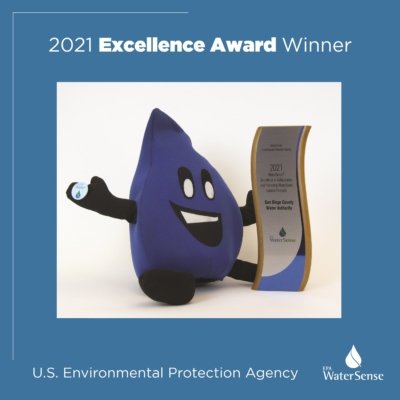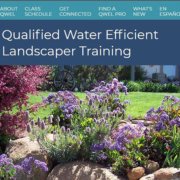The U.S. Environmental Protection Agency has recognized the San Diego County Water Authority with a 2021 WaterSense Excellence Award for advancing water efficiency through its Qualified Water Efficient Landscaper, or QWEL, program. The Water Authority received one of 34 WaterSense awards last week at the national WaterSmart Innovations Conference in Las Vegas.
Due to the coronavirus pandemic, the Water Authority pivoted its QWEL courses to a virtual format. The Water Authority partnered with San Diego Gas & Electric to install nearly 4,000 WaterSense-labeled showerheads for county residents and helped reduce outdoor water waste by using its WaterSmart Contractor Incentive Program to install more than 1,000 WaterSense-labeled irrigation controller stations, saving more than 6 million gallons of water.
“Working collaboratively with the EPA to increase water efficiency by training hundreds of landscape professionals each year makes a significant contribution to saving water, especially during dry times,” said Gary Croucher, Board chair of the San Diego County Water Authority. “The QWEL program is an effective education program for landscape professionals that provides the knowledge and skills needed to help our communities save water and keep landscapes healthy and beautiful.”

The U.S. Environmental Protection Agency has recognized the San Diego County Water Authority with a 2021 WaterSense Excellence Award for advancing water efficiency through its Qualified Water Efficient Landscaper, or QWEL, program.
As one of the first QWEL providers in Southern California, the Water Authority has helped to expand the program’s branded outreach and educational outcomes. Since the January 2016 launch of QWEL, more than 1,400 San Diego landscape professionals have participated, making the region’s program one of the largest in the nation. More than 800 landscape professionals have earned QWEL certificates in the San Diego region over the past six years by passing a rigorous national test.
Landscape water efficiency
The Water Authority promotes English and Spanish QWEL training in collaboration with trade associations, faith-based organizations, English-as-a-Second-Language programs, community colleges and Master Gardeners associations. Nearly all (99%) program participants surveyed said the class would help them better manage landscape water efficiency, and 98% rated the class good or excellent.
This is the third time the Water Authority has achieved the Excellence Award for the QWEL program, which is certified by EPA to significantly increase water management skills and knowledge among landscape professionals.
WaterSense works
WaterSense, a voluntary partnership program sponsored by EPA, is both a label for water-efficient products and homes and a resource for helping consumers learn ways to save water. Since the program started in 2006, WaterSense labeled products have helped consumers and businesses save 5.3 trillion gallons of water – enough water to supply all households in the United States with water for 200 days! In addition to water savings, WaterSense has helped reduce the amount of energy needed to heat, pump, and treat water by 603 billion kilowatt hours and save $108 billion in water and energy bills.
“In 2020, our WaterSense partners continued to make saving water possible by educating consumers and businesses about WaterSense and water-efficient behaviors,” said Veronica Blette, the WaterSense program manager. “Our award winners’ creative and committed approaches to water conservation helped consumers save water, energy, and money on their utility bills at a time when they needed it most.”
The San Diego regional QWEL program is made possible in part by grant funds from voter-approved Proposition 1 administered by the California Department of Water Resources.
For more information about WaterSense go to: :www.epa.gov/watersense.
For more about the Water Authority’s QWEL program, go to: https://qwel.watersmartsd.org/.





